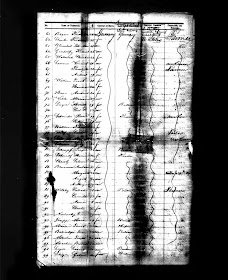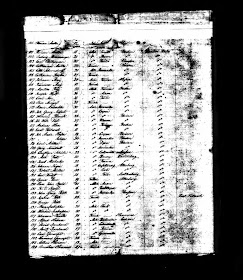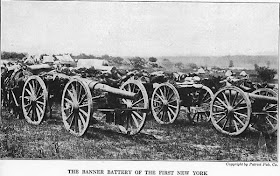 |
Gravestone of Andrew Henn (taken by Frank K for Find-a-grave.com)
Click to make bigger
|
This is my latest post for the “52 Ancestors in 52 Weeks” challenge initiated by Amy Johnson Crow of the
No Story Too Small blog. For more information about the challenge and links to the other blogs participating in the challenge, please click on the badge in the right margin.
As those who follow my blog know I have some notes and research done by some of my ancestors on both sides of my family that I have used as clues in doing my own research, and occasionally quoted in this blog. Those notes and such have usually turned out to be partially accurate, some more accurate than others. Most often there are a few grains of truth that help me confirm what I find belongs to my family (for an example see my post on
Elizabeth Manley Bixler Wolfington Moore) then decided to check Great-Aunt Lucille’s book,
Members of the Flock, to see if she ever talked about Andrew. Yikes! Yes, she reports a memory of my grandfather’s about an "Uncle Andrew" but he doesn’t sound remotely the same as the man I researched! I was then up ‘til 3:00 AM last night double-checking my trails and trying to find our Andrew in the places mentioned in Lucille’s book. I gave up. I don’t know if the book references the same man or if there is another Uncle Andrew that I haven’t found yet. I decided to tell you what the book said (it’s brief) and present what I found and if any can give me any further information/stories about Andrew that help resolve this, or even if they don’t, I’ll welcome you and them with open arms! Please leave a comment below or email me at the address on the “
Contact Me” page. I will respond as quickly as I can.
In Great-Aunt Lucille's book, my grandfather, Owen Carl Henn, remembered the following brief story about "Uncle Andrew Henn, who “was an Immigration Officer on Ellis Island, New York City. Later he returned. I mean, retired, and lived in Florida. Mom and Dad visited him one time, and Dad was challenged by the sight of a checkerboard. Dad always prided himself as a fairly good checker player, and thought it a good way to pass the time. But Uncle Andrew proved himself to be a checker champion. Dad couldn’t do any good at all.”
Andrew Henn is my 2
nd great grand uncle on my father’s father’s side. He was born to
Franz Joseph and Katharina Phillipine[Blank] Henn on January 20, 1832 in Baden, Germany; he was baptized/christened, Andreas Henn, as a Catholic on January 23, 1832 at Doerlesberg, Mosbach, Germany. His siblings were Genevieve “Genofera” [Scheer] (1827-1916), Serena Mary [Dick] (1828-1918); Dorothea “Dorothe” [Snyder] (1830-1896);
Rosa “Generosa”[Strauss] (1836-1908), Edmund (1838-1861),
John “Josephat” (1842-1919), Frank “Franz Joseph” (1843-1928), and Josephine “Josepha” [Schueurmann] (1849-1876).
I know nothing personal the first twenty years of his life. But mid-Century Germany was experiencing upheavals, with the failure of the revolution in 1848 to bring Democracy to the country, economic uncertainty, and, in some cases, religious persecution, that were encouraging a boom in emigration to the United States for the chance at a new and better life. In addition, better communication and travel meant that Germans in the interior knew more about emigration and found it to be more of a possibility. Those that left were generally small farmers, not rich, but also not the poor. These mid-century immigrants had enough resources to finance their trip, but not enough to make them want to stay in Germany if there were other opportunities. When they hit the American shore they went west looking for fertile farmland.
Nearly 1 million Germans emigrated to the U.S in the 1850’s, and among them was Andreas Henn. In taking ship for Germany he would likely have not only had to pay his passage, in steerage, but also bring all of his own food for the trip, which would have lasted approximately 30-45 days. (See
here for a collection of letters describing the voyage from Germany to the USA.) I don’t know why he struck off on his own at age 20 but we know that he arrived here in 1852, one year before the rest of the family followed. I’ve found two possibilities for the ship he arrived on. The first is the ship “Schiller” which left from the port of Bremen, and arrived at Castle Garden NY (it was before Ellis Island existed) on April 1, 1852; the passenger list shows “Andreas Hen”, male, age 20, from Baden, was aboard. The other possibility is the ship “Radius” which departed from the port of Le Havre, France and arrived at Castle Garden on October 14, 1852; the passenger list shows “Andreas Henn”, age 20, female, from Germany was aboard traveling steerage. Even though Bremen is a lot closer to Baden than Le Havre, I lean towards the Radius as the correct ship. I think the “Female is a misprint because Andreas is not a female name in German. I lean towards Le Havre because the next year the rest of the family left out of Le Havre and I would think that they would follow in his footsteps if he were successful. I might be wrong though. In any event, he arrived in 1852 and made his way to Syracuse NY (Onondaga County) initially, where there was a large German community.
 |
Passenger List for Ship "Radius"
Click to make bigger |
 |
Passenger List for Ship "Schiller"
Click to make bigger |
By 1855, though, he and the rest of the family had moved up to West Monroe in Oswego County, NY. As the Erie Canal and the Oswego Canal met in Syracuse, it was easy to get there and back to Syracuse as necessary. Andrew worked as a cooper [Here is a
You Tube video demonstrating a Cooper at work - it's interesting!]. In 1859, he married Sarah Deacon, and by the time of the federal census the next year, they had a one month old son, Charles (1860-?). Two years later they had a daughter, Hattie [Baum} (1862-1931), and two years after that another daughter, Ida (1864-1884).
On February 9, 1864, he enlisted as a private in Battery G of the 3rd NY Light Artillery, for a three year period. It was commanded by Capt. David L. Aberdeen [duty at New Berne and other points in North Carolina till March, 1865. Campaign of the Carolinas March 1-April 26. Southwest Creek March 7. Battle of Kinston or Wise Forts March 8-10. Occupation of Goldsboro March 21. Bennett's House April 26. Surrender of Johnston and his army. Duty in the Dept. of North Carolina till June], and was mustered out under Capt. William A. Kelsey, July 7, 1865, at Syracuse.
 |
1st NY Light Artillery
out of copyright |
He returned to Oswego County and took up farming. He reported on the Non-population farming Censuses in 1870 and 1880. His farm was a bit bigger in 1870 (15 acres improved 10 acres woodland) than in 1880 (8 acres tilled, 5 acres permanent meadows, and 7 permanent woodland), and valued about $300 more. I’m wondering if he could no longer maintain the bigger farm, since he filed for a civil war disability pension on December 9, 1979; it was granted. He indicated later, in 1890, on a NY Veteran’s schedule that he had chronic diarrhea and spinal difficulties. In both non-population schedules he indicated he had 1 horse, 2 cows, 2-3 sheep, 2 swine and 2 poultry. Between 1870 and 1880 he went from producing 120 bushels of Indian corn to 40 bushels and 95 bushels of oats to 40, but his production of buckwheat doubled in that time frame, and his production of Irish potatoes and butter remained the same.
The local paper, The Baldwinsville Gazette Farmers Journal reported that Andrew and Sarah had a fairly active social life over the years with many friends and family visiting, and Sarah being very active in the Ladies’ Aid Society. They also knew tragedy. Their youngest daughter, Ida, died in 1884 at age 20, and the local paper reported that Andrew Henn’s sister Rosa died on August 31, 1908. In fact, Andrew outlived three of his siblings. Andrew continued farming at least through 1910, per the census, and probably to the end, as he died the next year, on April 21, 1911, at age 79.
-----------------------------------------------------
I’d like to find out whether I have the wrong “Uncle Andrew” or who my grandfather was speaking of when he described “Uncle Andrew” as working at Ellis Island (that would also be a fascinating story) and retiring to Florida.
As always I’d like more detail about his life, and a picture or two. Perhaps there is more in the land records or probate records.
------------------------------------------------------
Ancestry.com. Germany, Select Births and Baptisms, 1558-1898 [database on-line]. Provo, UT, USA: Ancestry.com Operations, Inc., 2014. Original data: Germany, Births and Baptisms, 1558-1898. Salt Lake City, Utah: FamilySearch, 2013.; http://www.loc.gov/rr/european/imde/germchro.html; http://en.wikipedia.org/wiki/Germans_in_Syracuse,_New_York; http://freepages.genealogy.rootsweb.ancestry.com/~mstone/timeline.html; http://www.understandingyourancestors.com/ia/germanImmigration.aspx; http://www.energyofanation.org/4e667f77-e302-4c1a-9d2e-178a0ca31a32.html?NodeId=; http://19thcenturyrhinelandlive.blogspot.com/2014/02/emigrants-setting-sail-questions-and_28.html; http://dmna.ny.gov/historic/reghist/civil/artillery/3rdArtLight/3rdArtLtMain.htm; NY Find A Grave Memorial#
34893720; Fold3.com; NY census for 1855, 1892 & 1905; US Census for 1860, 1870, 1880, 1900, 1010, including non population surveys for 1870 & 1880. And NY Veterans Report for 1890.








On the ship Radius, Oct 1852, were another two passengers, The Prince of Poland and his bride to be, Marie Antoinette Gemperle, from the Port of NY, went to Albany, married, settled into New Bremen, Lewis, NY 1852, lived there 10 years, returned to their Castle in Poland. Had several children born in New York State. What is interesting is the immigrants that arrived earlier, 1844, the Kosters & L'eplattinier (Laplatney) Families from Switzerland, left for America, they settled into New Bremen, and prepared the way for the exiled Prince Ludwig Sulkowski, Prince of Belitz. This history now has more confirmation, I wish to add another fact, Syracuse is known as "Salt City", salt was very important in the early years. The Prince owned salt mines in Krakow. Note that a Polish General was hung at Fort Henry, Canada 1839 (Patriot War of 1838), he was in the salt business also. This settlement in New Bremen New York has a ton of history, many French, German, & Polish Families, with living descendants today. When the life of Napoleon, his brother Joseph, & other family members are linked to this data-one may say "Holy Cow!". My wife's ancestors lived in New Bremen, some owned a cheese plant there, others are buried there, the irony is, they are English, from the earliest colonists that settled the USA. You now see,the draw that brought these people here, rich fertile land, huge forests, salt, plenty of it, wonderful waterways, and exiled royalty from Europe. Joseph Bonaparte 1816-1832, owned 26,000 acres in Lewis county, exiled ruler of France was here 1812, (Mansion on Mueller Hill, South Otselic, NY), Prince Ludwig Sulkowski lived here 1852-1862, General Von Shultz hung 1839 at Fort Henry, Canada, over 100 of his comrades shipped to Australia & New Zealand for their part in the invasion. I've passed some important info your way, note their is a special group of Prussians in Canada, have to look up the files. Oh, the Bishop from Ogdensburg, NY made a recent trip to this community in Lewis County, the families remain close today.
ReplyDeleteQuite interesting. Thank you for taking the time to share that. I'd not heard about the Prince of Poland being on the ship nor his connections to salt mines. I knew of Syracuse's salt mines -- the Henn's were coopers who made barrels to ship the salt in, and my second great grandfather moved to Michigan in order to get lumber to make barrel staves and ship them back to Syracuse to be made into barrels for the salt.
DeleteCoincidentally, I've just spent the weekend reading histories about the Rebellions of 1837 and 1838 in preparation for a new blog post on another ancestor, so I just recently learned of the hangings and exiles. My other ancestors were on the Anglo/British side of that slice of history, though.
Thanks for the special tidbits. I'm intrigued now.